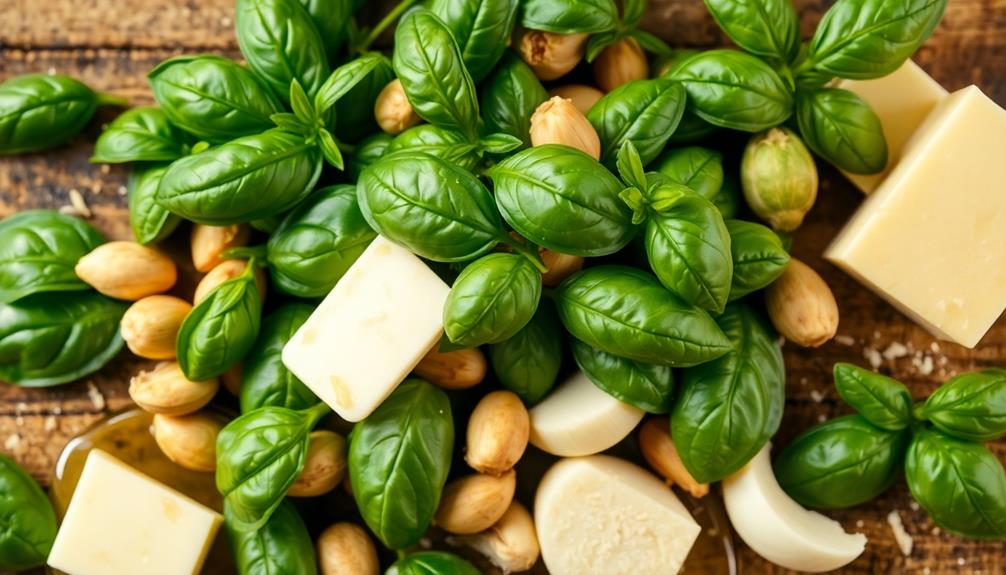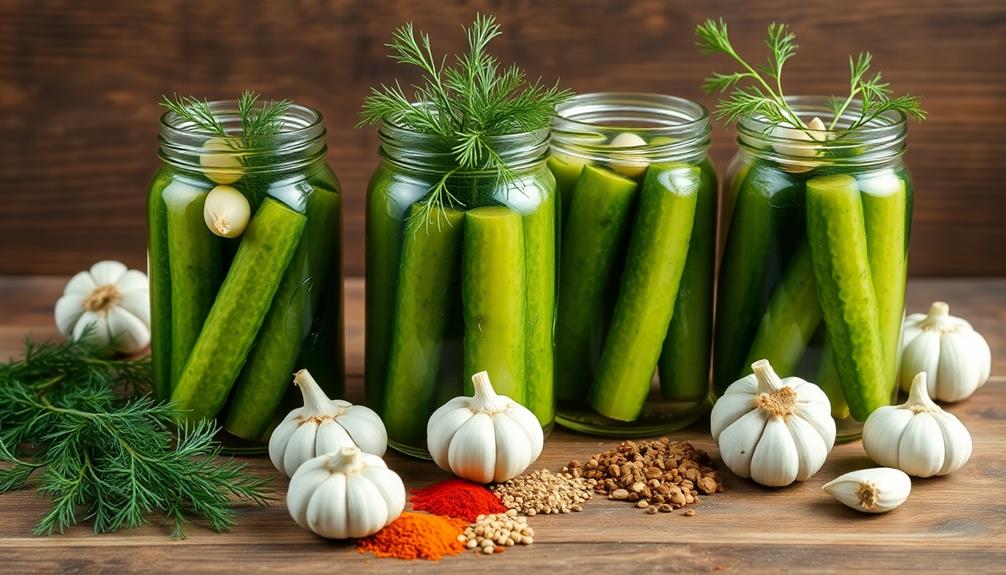Making homemade pesto is easier than you might think! This vibrant Italian sauce originated in 16th century Genoa, and with just a few simple ingredients – fresh basil, toasted pine nuts, garlic, Parmesan cheese, and olive oil – you can create a flavorful pesto that elevates a variety of dishes. The key is blending the ingredients until smooth and creamy, then tossing the pesto with freshly cooked pasta or using it as a spread on bread and crostini. Want to learn more about the rich history of pesto and discover some creative serving suggestions? Keep reading to uncover the full story behind this versatile culinary delight.
Key Takeaways
- Make pesto in a food processor by blending fresh basil, toasted pine nuts, garlic, Parmesan cheese, and high-quality olive oil for a quick and flavorful sauce.
- Adjust ingredient proportions to suit personal taste preferences, such as adding more or less garlic or using different types of nuts.
- Toss the homemade pesto with freshly cooked pasta or use it as a spread on bread, crostini, or as a topping for meats and vegetables.
- Freeze pesto in an airtight container to enjoy the fresh flavors year-round, and thaw it as needed for easy meal preparation.
- Homemade pesto offers superior taste and freshness compared to store-bought varieties, and allows for control over the ingredients used.
History

Pesto sauce has a long and storied history, dating back to the 16th century in the Genoa region of Italy. The word "pesto" comes from the Italian verb "pestare," which means "to pound" or "to crush." This refers to the traditional method of making pesto, which involves using a mortar and pestle to grind the ingredients into a smooth paste.
The classic pesto alla genovese is made with just a few simple ingredients: fresh basil, garlic, pine nuts, Parmesan cheese, and olive oil. Over the centuries, this vibrant green sauce has become a beloved staple in Italian cuisine, spreading far beyond its Genovese roots.
Though the core ingredients remain the same, modern pesto recipes often incorporate variations, such as using different nuts, herbs, or cheeses.
Today, pesto is enjoyed worldwide as a versatile condiment, adding flavor to pasta, pizza, sandwiches, and more. Its enduring popularity is a testament to the timeless appeal of this fresh, fragrant, and delicious sauce.
Recipe

Pesto is a classic Italian sauce that's versatile, flavorful, and incredibly easy to make at home. This homemade version combines fresh basil, toasted pine nuts, garlic, Parmesan cheese, and high-quality olive oil for a richly textured and vibrant sauce.
With the addition of seasonal herbs, you can even experiment with flavors inspired by herb-infused cocktails, making your pesto unique and refreshing.
The beauty of pesto is its simplicity. With just a few simple ingredients, you can create a sauce that elevates pasta, pizza, sandwiches, and more. Plus, it's a great way to use up an abundance of fresh basil from your garden or the local market.
Ingredients:
- 2 cups packed fresh basil leaves
- 1/2 cup toasted pine nuts
- 3 cloves garlic, minced
- 1/2 cup grated Parmesan cheese
- 1/2 cup high-quality extra-virgin olive oil
- 1/4 teaspoon salt
- 1/8 teaspoon freshly ground black pepper
Instructions:
In a food processor or high-powered blender, combine the basil, pine nuts, garlic, Parmesan, olive oil, salt, and pepper. Pulse until a smooth, creamy sauce forms, scraping down the sides as needed. Adjust seasoning to taste.
To use, toss the pesto with freshly cooked pasta, spoon it over grilled meats or vegetables, or spread it on sandwiches and pizza. You can also mix pesto into salads for an extra burst of flavor or use it as a dip for crusty bread. For a heartier meal option, try stirring it into cooked grains like quinoa, which pairs wonderfully with its rich, herbaceous notes. If you’re unsure, you can easily find guides on *how to prepare quinoa* that make it simple to incorporate into your dishes. For those who are new to this versatile grain, learning *how to cook quinoa* is a breeze and can add a nutritious base to your meals. Once prepared, the fluffy texture of quinoa absorbs the flavors of pesto beautifully, making for a delicious and wholesome dish. Whether you’re crafting a vibrant salad or a hearty bowl, this combination is sure to delight your taste buds. If you’re looking to elevate your meal prep, this duo of pesto and quinoa is as practical as it is delicious, offering endless opportunities for customization. For beginners, learning how to cook quinoa easily opens the door to creating balanced and flavorful dishes without much hassle. Once you’ve mastered its preparation, the possibilities are endless—from pesto-infused quinoa bowls to creative side dishes that steal the spotlight.
Pesto also freezes well, so consider making a larger batch and storing it in an airtight container for future use. When ready to use the frozen pesto, simply thaw it in the refrigerator or at room temperature.
Cooking Steps
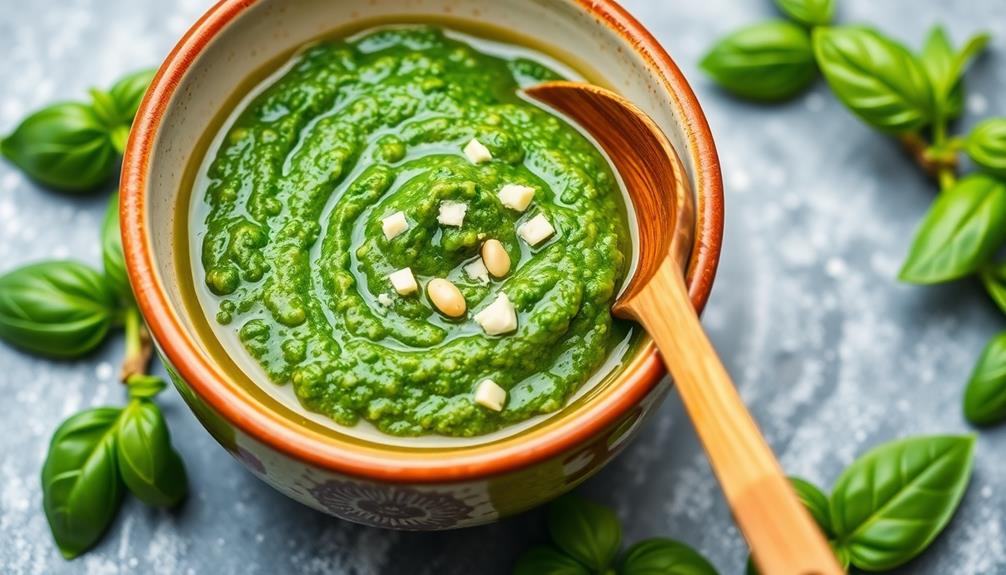
In your food processor, gather all the necessary ingredients.
Blend them together until they're thoroughly incorporated.
Once done, transfer the pesto to a serving bowl and refrigerate it until you're ready to serve it.
To finish, garnish the pesto with some toasted pine nuts for a delightful flavor and texture contrast.
Step 1. Gather Ingredients in Food Processor

To begin, you'll want to gather all the necessary ingredients in your food processor. First, add a couple of cups of fresh basil leaves, ensuring they're thoroughly washed and dried.
Next, toss in a handful of pine nuts, which will add a delightful crunch to your pesto. Don't forget the garlic – about 3 to 4 cloves should do the trick.
For a creamy, rich texture, include a quarter cup of freshly grated Parmesan cheese. Lastly, drizzle in a few tablespoons of high-quality olive oil.
With all the ingredients in the food processor, it's time to blend. Start on a low speed and gradually increase to high, letting the machine run for about 30 seconds to a minute.
Stop and scrape down the sides as needed to ensure everything is evenly incorporated. The goal is a smooth, vibrant green pesto sauce.
Adjust any seasoning to your taste, and you're ready to use your homemade pesto in a variety of dishes!
Step 2. Blend Until Thoroughly Incorporated

With all the ingredients now in the food processor, it's time to blend until thoroughly incorporated. Press the "on" button and let the machine do its work, pulsing the mixture a few times to begin.
The pesto will start to take shape as the basil leaves, pine nuts, garlic, and Parmesan cheese are finely chopped and combined. As the blades spin, gradually drizzle in the olive oil. This helps emulsify the sauce, blending all the flavors together into a smooth, creamy consistency.
Scrape down the sides of the bowl as needed to ensure even mixing. Continue blending for 1-2 minutes, or until the pesto reaches your desired texture. It should have a bright green hue and a thick, spreadable quality.
If the mixture seems too thick, add a bit more oil. Conversely, if it's too thin, let it blend for a little longer. Once the pesto is thoroughly incorporated, it's ready to use.
Proceed to the next step to learn how to serve this flavorful homemade sauce.
Step 3. Transfer to Serving Bowl

Transferring the freshly blended pesto to a serving bowl is the next step. This allows you to easily transfer the pesto to your desired dishes or store it for later use.
Scoop the vibrant, fragrant pesto from the food processor and gently spoon it into a medium-sized serving bowl. Use a rubber spatula to ensure you gather every last bit of the tasty sauce.
Once in the bowl, you can give the pesto a final stir to incorporate any remaining ingredients. This helps achieve a smooth, cohesive texture.
If you'd like, you can drizzle a bit of extra olive oil over the top to help preserve the pesto's brilliant green color.
The pesto is now ready to be enjoyed! You can serve it immediately with your favorite pasta, spread it on crostini, or use it as a flavorful topping for meat, fish, or vegetables.
Alternatively, transfer the pesto to an airtight container and refrigerate for up to one week, or freeze for longer-term storage.
Step 4. Refrigerate Until Ready to Serve
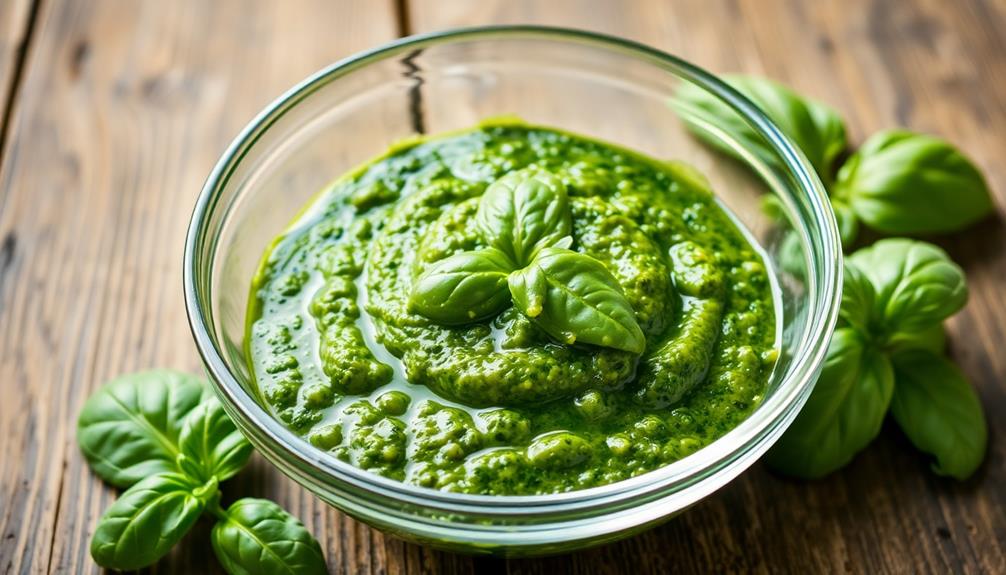
If you're not ready to serve the pesto right away, refrigerate it until you are. The pesto can be stored in an airtight container in the refrigerator for up to 5 days. This will help preserve the vibrant green color and fresh flavor of the pesto.
When you're ready to use the pesto, simply take it out of the fridge and let it come to room temperature. The pesto may thicken up a bit in the fridge, so you may need to stir it to loosen it up before serving.
The pesto can be used in a variety of ways:
- Toss it with freshly cooked pasta
- Spread it on bread or crostini
- Use it as a dip for raw vegetables
- Mix it into soups or stews for extra flavor
- Spread it on pizza or flatbread before baking
No matter how you choose to serve it, the homemade pesto will add a delicious, fresh taste to your meal. Enjoy!
Step 5. Garnish With Toasted Pine Nuts

Toasted pine nuts make a lovely garnish that adds a delightful crunch and nutty flavor to the pesto. To prepare them, simply place the pine nuts in a dry skillet over medium heat. Toast them, stirring frequently, until they're fragrant and lightly golden, about 3-5 minutes. Be careful not to let them burn.
Once toasted, transfer the pine nuts to a plate or bowl to cool. This step brings out their natural oils, intensifying their flavor.
When the pesto is ready to serve, sprinkle a generous amount of the toasted pine nuts over the top. The contrast of the soft, herbal pesto and the crunchy, nutty pine nuts creates a delightful textural and flavor experience.
The toasted pine nuts also add a touch of visual appeal, making the pesto even more appetizing.
Feel free to toast a few extra nuts to have on hand as a tasty snack or to use as a garnish for other dishes.
Final Thoughts
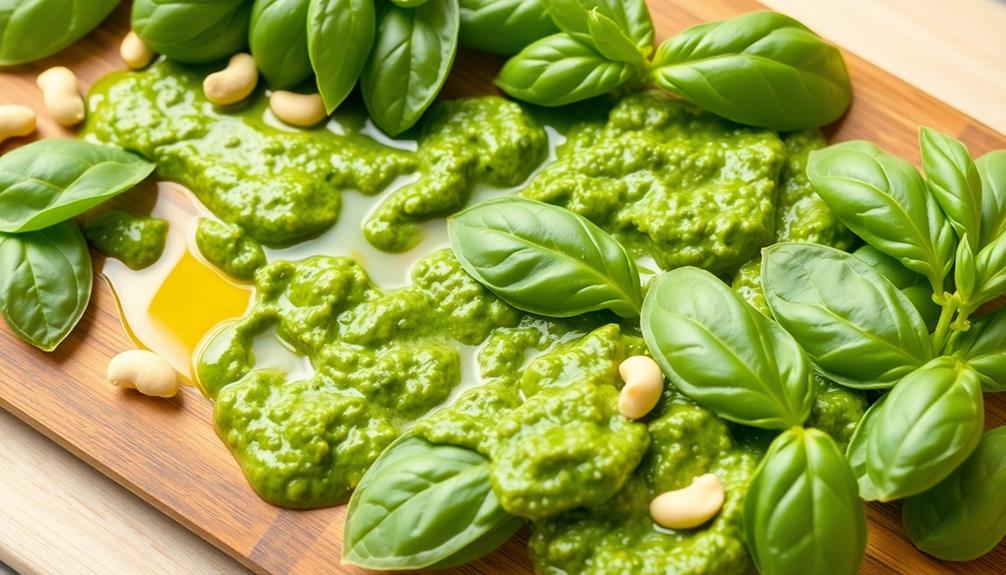
Making homemade pesto is a rewarding and flavorful endeavor. From the vibrant green color to the mouthwatering aroma, the final result is sure to impress. Not only is pesto a versatile sauce that can be used in a variety of dishes, but the process of making it at home allows for complete control over the ingredients.
When crafting your own pesto, take pride in the fact that you've created something exceptional. The time and care you've invested will shine through in the depth of flavor.
Consider experimenting with different variations, such as using walnuts or almonds instead of pine nuts, or adding a hint of lemon zest for a brightness that complements the basil.
No matter how you choose to enjoy your homemade pesto, savor the satisfaction of having made it yourself. It's a testament to your culinary skills and a delicious way to elevate any meal.
Frequently Asked Questions
How Long Does Homemade Pesto Sauce Last in the Refrigerator?
Homemade pesto sauce typically lasts 3-5 days in the refrigerator when stored properly. For the best quality and flavor, you should consume it within this timeframe. Proper storage is key to maximizing its freshness and avoiding spoilage.
Can I Use Any Type of Nuts in Pesto?
You can use any type of nuts in pesto, but the most common are pine nuts, walnuts, and almonds. The flavor and texture will vary depending on the nut you choose, so feel free to experiment.
Is It Necessary to Toast the Pine Nuts?
It's not strictly necessary to toast the pine nuts, but toasting them will enhance their flavor and give the pesto a richer, nuttier taste. The choice is yours – toasted or untoasted, your pesto will still be delicious.
How Can I Make Pesto Thicker or Creamier?
To make your pesto thicker or creamier, you can try adding more olive oil, grated Parmesan cheese, or toasted pine nuts. You can also blend the ingredients for a longer period to achieve a smoother consistency.
Can I Freeze Homemade Pesto for Later Use?
Yes, you can freeze homemade pesto for later use. Simply place it in an airtight container or freezer bag, leaving minimal air space, and it'll keep for up to 6 months. When ready to use, thaw in the refrigerator overnight.
